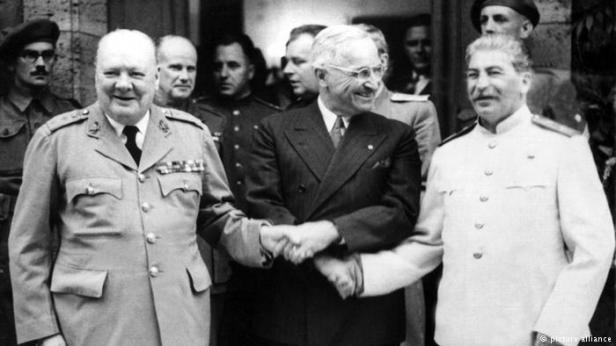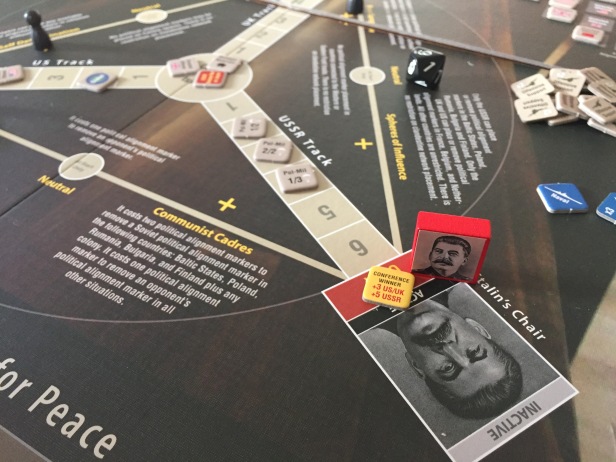On July 17, 1945, the final “Big Three” meeting between the United States, the Soviet Union, and Great Britain takes place towards the end of World War II. The decisions reached at the conference ostensibly settled many of the pressing issues between the three wartime allies, but the meeting was also marked by growing suspicion and tension between the United States and the Soviet Union. U.S. President Harry S. Truman, Soviet leader Joseph Stalin, and British Prime Minister Winston Churchill met in the Berlin suburb of Potsdam to discuss issues relating to postwar Europe and plans to deal with the ongoing conflict with Japan. By the time the meeting began, U.S. and British suspicions concerning Soviet intentions in Europe were intensifying. Russian armies occupied most of Eastern Europe, including nearly half of Germany, and Stalin showed no inclination to remove his control of the region. In fact, things were so bad that Winston Churchill had tasked his senior military advisors to plan for an invasion of Russia if things didn’t improve. This was called Operation Unthinkable and you can read more about that event as well as an interview with the designer Ty Bomba of an upcoming game from Hollandspiele called Operation Unthinkable: Churchill’s World War III.

Truman, who had only been president since Franklin D. Roosevelt died three months earlier, arrived at the meeting determined to be “tough” with Stalin. He was encouraged in this course of action by news that American scientists had just successfully tested the atomic bomb. The conference soon bogged down on the issue of postwar Germany. The Soviets wanted a united but disarmed Germany, with each of the Allied powers determining the destiny of the defeated power. Truman and his advisors, fearing the spread of Soviet influence over all Germany and, by extension, all of western Europe, fought for and achieved an agreement whereby each Allied power (including France) would administer a zone of occupation in Germany. Russian influence, therefore, would be limited to its own eastern zone. The United States also limited the amount of reparations Russia could take from Germany. Discussion of the continuing Soviet occupation of Poland floundered. When the conference ended on August 2, 1945, matters stood much where they had before the meeting. There would be no further wartime conferences. Four days after the conference concluded on August 6th, the United States dropped an atomic bomb on Hiroshima in Japan; on August 9th, another bomb was dropped on Nagasaki. World War II officially came to an end on August 14, 1945.

Churchill Big Three Struggle for Peace from GMT Games
One of Mark Herman’s games that I have truly enjoyed is Churchill Big Three Struggle for Peace. This game is not a wargame but deals with war as you control one of three leaders from the Big Three nations of the United States (Roosevelt and later Truman), Russia (Stalin) or the United Kingdom (Churchill) as you attempt to debate issues dealing with how to conduct the war in Europe and the Pacific, how to bring it to a swift close and how to deal with the political future of those countries after the peace is secured. The central mechanic in the game, and the best part about playing, is the conference table, which is a queue where each player has a track ranging from 1 to 6 upon which they are attempting to place issues on, and through the skillful use of their deck of Staff cards, win those issues to allow them to use them to their advantage in waging the war or preparing their future after the war is over. After the conference segment is over, a winner is determined and they get to use the issues that ended on their track to perform various actions including clandestine operations, political activity, and military offensives. I had never really played a game like this before and really haven’t since. Churchill is special and I highly recommend it if you enjoy thinky games that require you to have a planned strategy, but also that require you to pay attention throughout the game to that strategy as it must be realigned every few rounds to make sure you are keeping up with the competition.

Recently, I posted the first in a series of three strategy articles on Churchill. The first entry covered my favorite faction the Soviets, but look for future entries in the series on the United Kingdom and the mighty United States.
I hope you have enjoyed this edition of On This Day in Military History and I encourage you to give Churchill from GMT Games a try.
-Grant

Stalin was a sicko…much worse than Hitler could have ever dreamed of being. The atom bomb should have been dropped on Stalin’s house at the end of the conflict with Germany.
LikeLike
There was a plan called Operation Unthinkable put forward by the British to invade Russia at the end of the war in Europe.
LikeLike